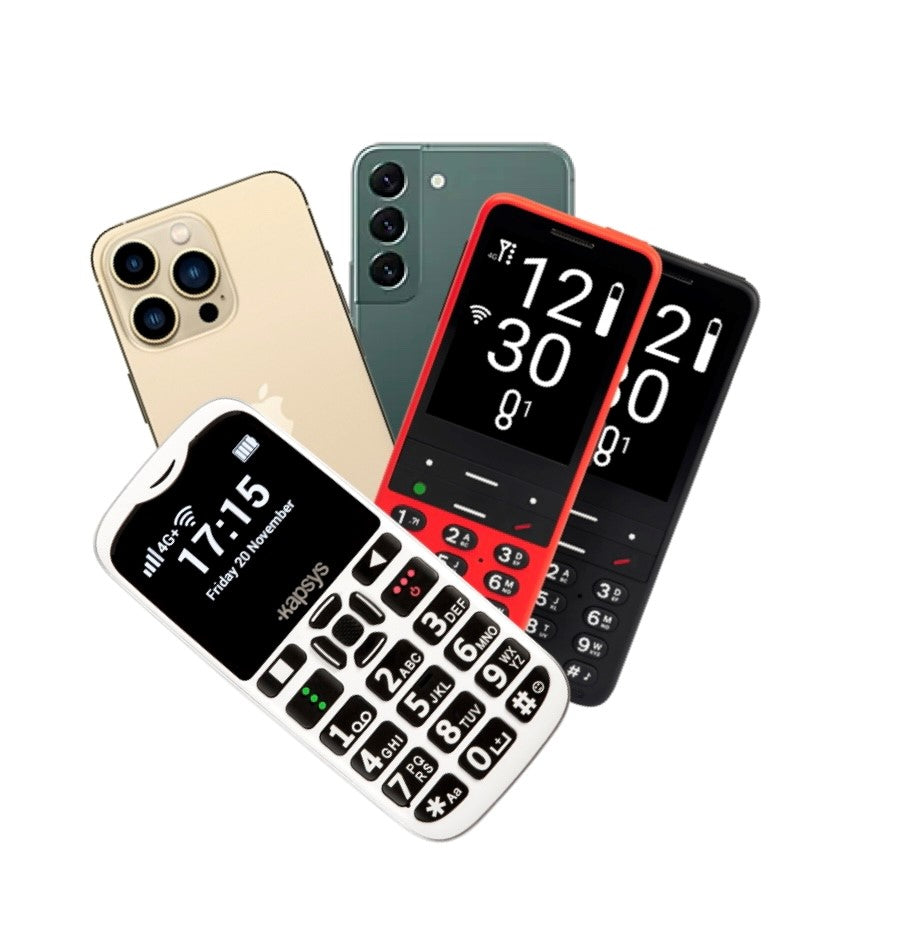Choosing a Cell Phone While Low Vision or Blind
Patrick AndradeShare This Article
First, ask yourself, what do I want to be able to do with my phone? Many low-vision or blind users want something to make calls or send texts on the go. Others want to surf the web or use ride-share apps.
Second, how many new things am I willing to learn? With great features comes great complexity. Keep in mind, the price becomes greater too! For your peace of mind, we’ve weighed the levels of complexity of each cell phone for you to consider.
Level One - Keep it Simple
The MiniVision 2

If you want an accessible cell phone that can make a call or send a text, the MiniVision 2+ (item: MV2-CELL) doesn’t get much more straightforward.
- Accessibility highlights: Tactile buttons that are large & high contrast. Fully vocalized operation. Some voice command capability (requires Wi-fi or data plan). Similar physical and menu structure to a flip phone for those already familiar.
- Notable Limitations: Small screen. It only operates for essential uses of calls, texts, voicemails, daily features like alarms, and some low vision features such as a money identifier.
- Price: $329
Level Two - Middle of the Road
The BlindShell Classic 2

Complex in features but not in use, the BlindShell Classic 2 (item BLS2-CELL) by RAZ Mobility is a great way to have many familiar smartphone apps and services without having to deal with a touchscreen.
- Accessibility highlights: Large, high-contrast screen. Large print. Tactile buttons. Fully vocalized operation. Vocal commands (requires Wi-fi or data plan).
- Notable Limitations: Only some apps are available to download, as you would see on a smartphone; because of this, no ride-share apps are currently available.
- Price: $489
Level Three - Knows No Bounds
Smartphones seem inaccessible out of the box, but almost all have features built-in you can enable to make it usable with any visual impairment. So why is this considered the most challenging of the three options? Learning how to help and use these features takes practice and isn’t always intuitive. If you choose this route, consider the limitations before purchasing and ask your representative if the phone has the particular feature you need. There are two different types of smartphones; therefore, consider below to be a comparison of both types.
iPhone
- Accessibility highlights: Best screen reader. Great assistant (Siri) for vocal commands. Auto speaker. Magnification for those with low vision. Talking caller ID. Large print. Dark theme/color inversion. Dictation. Talking keyboard. High contrast font. Selective screen reading. Some features might require the download of the Android Accessibility Suite.
- Notable Limitations: Section Reading of Selective Reading feature is relatively visual. Magnification gestures and operation can be complicated for some (usually those with hand/wrist conditions).
- Price: Steeper compared to Android, but it varies. Please discuss this with your service provider.
Android
- Accessibility highlights: Best magnification. Best selective screen reading. Dark theme/color inversion. AI assistant for vocal commands (Google Assistant). Dictation. Large print. Talking keyboard. Talking Caller ID. Auto Speaker. It should be noted that some of these features may require installation or are not available on every Android phone.
- Notable Limitations: All Androids are different and may require some installation of the accessibility features (the most commonly missing part that can be installed is the selective screen reading). Some Androids lack a feature, such as the hands-free Google Assistant, which makes this operation more difficult for those with low vision who can’t see the screen.
- Price: Varies - should be discussed with your service provider. Less expensive than an iPhone.
Level 3, but TACTILE!
If you want a smart phone what is holding you back is difficulty managing the screen reader gestures, the SmartVision 3 may be the one for you.
SmartVision 3
- Accessibility highlights: Tactile buttons that are large & high contrast. Fully vocalized operation. Dictation. AI assistant for vocal commands (Google Assistant). Similar physical structure to a flip phone for those who are already familiar. Can still use touch screen if preferred.
- Notable Limitations: Best for screen reader users, not for Low Vision accessibility features listed above in Android section. Only runs on Android operating system, which currently will not have updates.
- Price: $599 for Basic; $669 for Premium, meaning it includes accessories
BlindShell Classic 3
Brand new and introducing new features in addition to all that was on the BlindShell Classic 2, the hardware is the same except it's now additionally a touch screen for when you want to use flicks and swipes to navigate.
- Tandem app helps you stay connected with your loved ones.
- Luna can assist with anything, anywhere—just ask.
- Observo recognizes what's in the photo — clothes, objects, and colors. Just take a photo.
- Price: $690
Should you have any questions on the devices that were discussed above, you can call us directly at 1-800-919-3375.


1 comment
Print too small on screen, can’t see incoming messages or calls